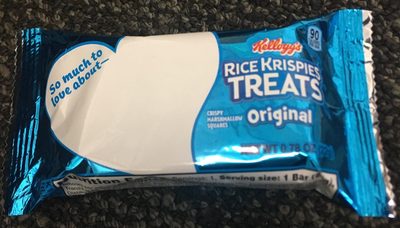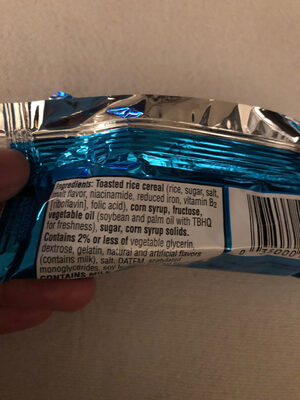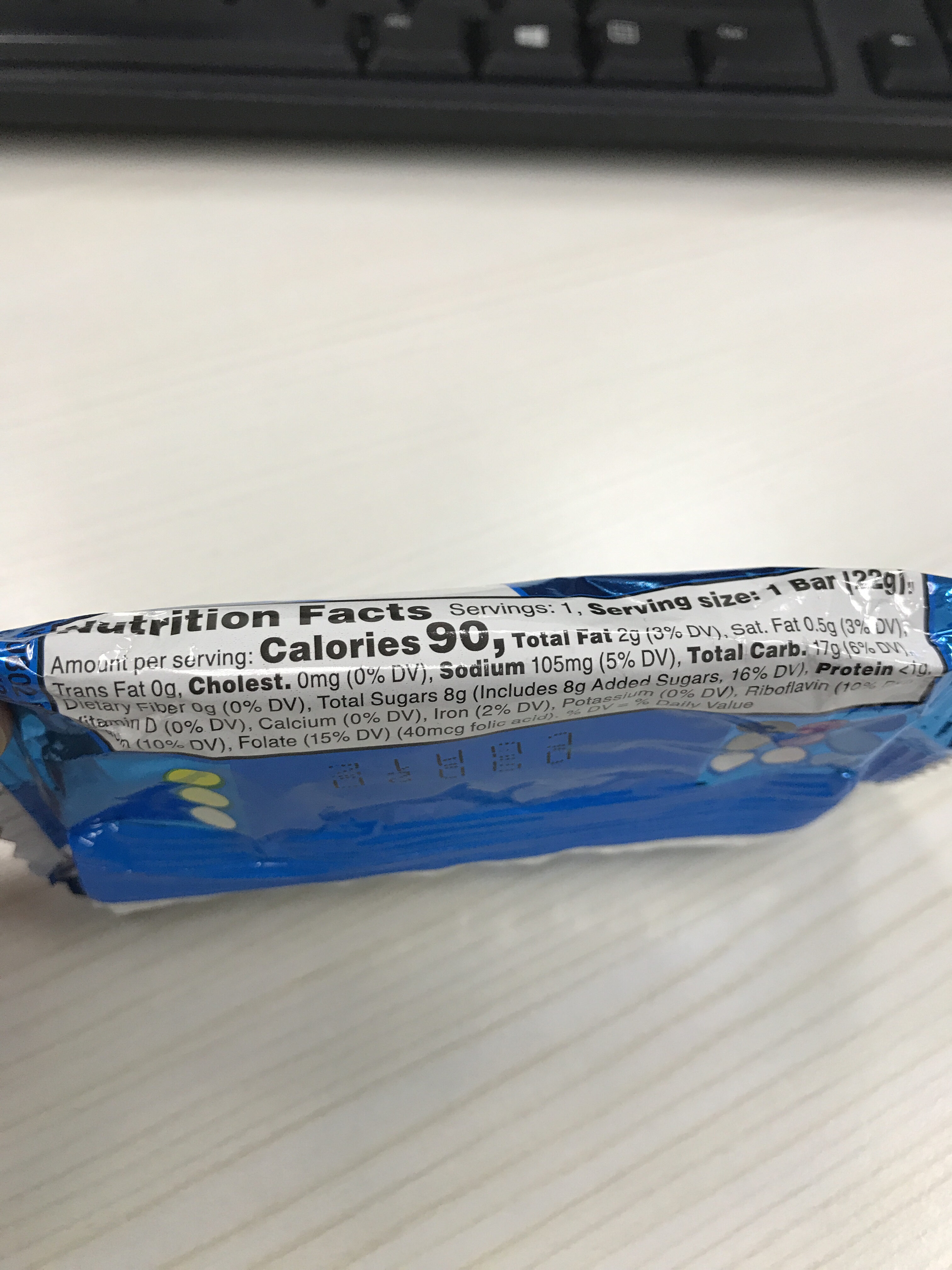Help us make food transparency the norm!
As a non-profit organization, we depend on your donations to continue informing consumers around the world about what they eat.
The food revolution starts with you!
The original crispy marshmallow squares, the original - Kellogg's - 0.78 oz
The original crispy marshmallow squares, the original - Kellogg's - 0.78 oz
This product page is not complete. You can help to complete it by editing it and adding more data from the photos we have, or by taking more photos using the app for Android or iPhone/iPad. Thank you!
×
Barcode: 0038000265013 (EAN / EAN-13) 038000265013 (UPC / UPC-A)
Quantity: 0.78 oz
Packaging: Mixed plastic-wrapper
Brands: Kellogg's
Brand owner: The Kellogg Company
Categories: Snacks, Sweet snacks, Confectioneries, Bars, Biscuits and cakes, Cakes, Cereal bars
Countries where sold: United States
Matching with your preferences
Health
Ingredients
-
37 ingredients
toasted rice cereal (rice, sugar, salt, malt flavoring, niacinamide, reduced iron, riboflavin [vitamin b2], folic acid), marshmallow (corn syrup, sugar, gelatin, natural and artificial flavor), fructose, margarine (vegetable oil [soybean and palm oil with tbhq for freshness], water, natural and artificial butter flavor [contains milk], datem, acetylated monoglycerides, bht for freshness, vitamin a palmitate, vitamin d), corn syrup solids, contains two percent or less of dextrose, glycerin, salt, niacinamide, pyridoxine hydrochloride (vitamin b6), thiamin hydrochloride (vitamin b1), riboflavin (vitamin b2), soy lecithinAllergens: Gelatin, Milk, Soybeans
Food processing
-
Ultra processed foods
Elements that indicate the product is in the 4 - Ultra processed food and drink products group:
- Additive: E322 - Lecithins
- Additive: E422 - Glycerol
- Additive: E428 - Gelatine
- Additive: E472e - Mono- and diacetyltartaric acid esters of mono- and diglycerides of fatty acids
- Ingredient: Flavouring
Food products are classified into 4 groups according to their degree of processing:
- Unprocessed or minimally processed foods
- Processed culinary ingredients
- Processed foods
- Ultra processed foods
The determination of the group is based on the category of the product and on the ingredients it contains.
Additives
-
E322 - Lecithins
Lecithins are natural compounds commonly used in the food industry as emulsifiers and stabilizers.
Extracted from sources like soybeans and eggs, lecithins consist of phospholipids that enhance the mixing of oil and water, ensuring smooth textures in various products like chocolates, dressings, and baked goods.
They do not present any known health risks.
-
E322i - Lecithin
Lecithins are natural compounds commonly used in the food industry as emulsifiers and stabilizers.
Extracted from sources like soybeans and eggs, lecithins consist of phospholipids that enhance the mixing of oil and water, ensuring smooth textures in various products like chocolates, dressings, and baked goods.
They do not present any known health risks.
-
E422 - Glycerol
Glycerol: Glycerol -; also called glycerine or glycerin; see spelling differences- is a simple polyol compound. It is a colorless, odorless, viscous liquid that is sweet-tasting and non-toxic. The glycerol backbone is found in all lipids known as triglycerides. It is widely used in the food industry as a sweetener and humectant and in pharmaceutical formulations. Glycerol has three hydroxyl groups that are responsible for its solubility in water and its hygroscopic nature.Source: Wikipedia
Ingredients analysis
-
May contain palm oil
Ingredients that may contain palm oil: E472e
-
Non-vegan
Non-vegan ingredients: E428Some ingredients could not be recognized.
We need your help!
You can help us recognize more ingredients and better analyze the list of ingredients for this product and others:
- Edit this product page to correct spelling mistakes in the ingredients list, and/or to remove ingredients in other languages and sentences that are not related to the ingredients.
- Add new entries, synonyms or translations to our multilingual lists of ingredients, ingredient processing methods, and labels.
If you would like to help, join the #ingredients channel on our Slack discussion space and/or learn about ingredients analysis on our wiki. Thank you!
-
Non-vegetarian
Non-vegetarian ingredients: E428Some ingredients could not be recognized.
We need your help!
You can help us recognize more ingredients and better analyze the list of ingredients for this product and others:
- Edit this product page to correct spelling mistakes in the ingredients list, and/or to remove ingredients in other languages and sentences that are not related to the ingredients.
- Add new entries, synonyms or translations to our multilingual lists of ingredients, ingredient processing methods, and labels.
If you would like to help, join the #ingredients channel on our Slack discussion space and/or learn about ingredients analysis on our wiki. Thank you!
-
Details of the analysis of the ingredients
We need your help!
Some ingredients could not be recognized.
We need your help!
You can help us recognize more ingredients and better analyze the list of ingredients for this product and others:
- Edit this product page to correct spelling mistakes in the ingredients list, and/or to remove ingredients in other languages and sentences that are not related to the ingredients.
- Add new entries, synonyms or translations to our multilingual lists of ingredients, ingredient processing methods, and labels.
If you would like to help, join the #ingredients channel on our Slack discussion space and/or learn about ingredients analysis on our wiki. Thank you!
: toasted rice cereal (rice, sugar, salt, malt flavoring, niacinamide, reduced iron, riboflavin (vitamin b2), folic acid), marshmallow (corn syrup, sugar, gelatin, natural and artificial flavor), fructose, margarine (vegetable oil (soybean and palm oil with tbhq for freshness), water, datem, acetylated monoglycerides, bht for freshness, vitamin a palmitate, vitamin d), corn syrup solids, contains two percent and less of dextrose, glycerin, salt, niacinamide, pyridoxine hydrochloride (vitamin b6), thiamin hydrochloride (vitamin b1), riboflavin (vitamin b2), soy lecithin- toasted rice cereal -> en:toasted-rice-cereal
- rice -> en:rice - vegan: yes - vegetarian: yes - ciqual_proxy_food_code: 9100
- sugar -> en:sugar - vegan: yes - vegetarian: yes - ciqual_proxy_food_code: 31016
- salt -> en:salt - vegan: yes - vegetarian: yes - ciqual_food_code: 11058
- malt flavoring -> en:malt-flavouring - vegan: maybe - vegetarian: maybe
- niacinamide -> en:e375 - vegan: maybe - vegetarian: maybe
- reduced iron -> en:reduced-iron
- riboflavin -> en:e101 - vegan: maybe - vegetarian: yes
- vitamin b2 -> en:e101 - vegan: maybe - vegetarian: yes
- folic acid -> en:folic-acid
- marshmallow -> en:marshmallow
- corn syrup -> en:corn-syrup - vegan: yes - vegetarian: yes - ciqual_proxy_food_code: 31089
- sugar -> en:sugar - vegan: yes - vegetarian: yes - ciqual_proxy_food_code: 31016
- gelatin -> en:e428 - vegan: no - vegetarian: no
- natural and artificial flavor -> en:natural-and-artificial-flavouring - vegan: maybe - vegetarian: maybe
- fructose -> en:fructose - vegan: yes - vegetarian: yes - ciqual_food_code: 31077
- margarine -> en:margarine
- vegetable oil -> en:vegetable-oil - vegan: yes - vegetarian: yes - from_palm_oil: maybe
- soybean and palm oil with tbhq for freshness -> en:soybean-and-palm-oil-with-tbhq-for-freshness
- water -> en:water - vegan: yes - vegetarian: yes - ciqual_food_code: 18066
- datem -> en:e472e - vegan: maybe - vegetarian: maybe - from_palm_oil: maybe
- acetylated monoglycerides -> en:acetylated-monoglycerides
- bht for freshness -> en:bht-for-freshness
- vitamin a palmitate -> en:retinyl-palmitate - vegan: yes - vegetarian: yes
- vitamin d -> en:vitamin-d
- vegetable oil -> en:vegetable-oil - vegan: yes - vegetarian: yes - from_palm_oil: maybe
- corn syrup solids -> en:corn-syrup-solids - vegan: yes - vegetarian: yes - ciqual_proxy_food_code: 31089
- contains two percent and less of dextrose -> en:contains-two-percent-and-less-of-dextrose
- glycerin -> en:e422 - vegan: maybe - vegetarian: maybe
- salt -> en:salt - vegan: yes - vegetarian: yes - ciqual_food_code: 11058
- niacinamide -> en:e375 - vegan: maybe - vegetarian: maybe
- pyridoxine hydrochloride -> en:pyridoxine-hydrochloride - vegan: yes - vegetarian: yes
- vitamin b6 -> en:vitamin-b6 - vegan: yes - vegetarian: yes
- thiamin hydrochloride -> en:thiamin-hydrochloride
- vitamin b1 -> en:thiamin
- riboflavin -> en:e101 - vegan: maybe - vegetarian: yes
- vitamin b2 -> en:e101 - vegan: maybe - vegetarian: yes
- soy lecithin -> en:soya-lecithin - vegan: yes - vegetarian: yes - ciqual_food_code: 42200
Nutrition
-
Bad nutritional quality
⚠ ️Warning: the amount of fruits, vegetables and nuts is not specified on the label, it was estimated from the list of ingredients: 0This product is not considered a beverage for the calculation of the Nutri-Score.
Positive points: 0
- Proteins: 2 / 5 (value: 4.55, rounded value: 4.55)
- Fiber: 0 / 5 (value: 0, rounded value: 0)
- Fruits, vegetables, nuts, and colza/walnut/olive oils: 0 / 5 (value: 0, rounded value: 0)
Negative points: 20
- Energy: 5 / 10 (value: 1711, rounded value: 1711)
- Sugars: 8 / 10 (value: 36.36, rounded value: 36.36)
- Saturated fat: 2 / 10 (value: 2.27, rounded value: 2.3)
- Sodium: 5 / 10 (value: 471, rounded value: 471)
The points for proteins are not counted because the negative points are greater or equal to 11.
Nutritional score: (20 - 0)
Nutri-Score:
-
Nutrient levels
-
Fat in moderate quantity (9.09%)
What you need to know- A high consumption of fat, especially saturated fats, can raise cholesterol, which increases the risk of heart diseases.
Recommendation: Limit the consumption of fat and saturated fat- Choose products with lower fat and saturated fat content.
-
Saturated fat in moderate quantity (2.27%)
What you need to know- A high consumption of fat, especially saturated fats, can raise cholesterol, which increases the risk of heart diseases.
Recommendation: Limit the consumption of fat and saturated fat- Choose products with lower fat and saturated fat content.
-
Sugars in high quantity (36.4%)
What you need to know- A high consumption of sugar can cause weight gain and tooth decay. It also augments the risk of type 2 diabetes and cardio-vascular diseases.
Recommendation: Limit the consumption of sugar and sugary drinks- Sugary drinks (such as sodas, fruit beverages, and fruit juices and nectars) should be limited as much as possible (no more than 1 glass a day).
- Choose products with lower sugar content and reduce the consumption of products with added sugars.
-
Salt in moderate quantity (1.18%)
What you need to know- A high consumption of salt (or sodium) can cause raised blood pressure, which can increase the risk of heart disease and stroke.
- Many people who have high blood pressure do not know it, as there are often no symptoms.
- Most people consume too much salt (on average 9 to 12 grams per day), around twice the recommended maximum level of intake.
Recommendation: Limit the consumption of salt and salted food- Reduce the quantity of salt used when cooking, and don't salt again at the table.
- Limit the consumption of salty snacks and choose products with lower salt content.
-
-
Nutrition facts
Nutrition facts As sold
for 100 g / 100 mlAs sold
per serving (1 Bar (22 g))Compared to: Cereal bars Energy 1,711 kj
(409 kcal)376 kj
(90 kcal)-3% Fat 9.09 g 2 g -41% Saturated fat 2.27 g 0.499 g -56% Monounsaturated fat 3.9 g 0.858 g -25% Polyunsaturated fat 2.6 g 0.572 g -5% Trans fat 0 g 0 g -100% Cholesterol 0 mg 0 mg -100% Carbohydrates 77.27 g 17 g +31% Sugars 36.36 g 8 g +42% Fiber 0 g 0 g -100% Soluble fiber 0 g 0 g -100% Insoluble fiber 0 g 0 g -100% Proteins 4.55 g 1 g -44% Salt 1.178 g 0.259 g +188% Vitamin A 272.7 µg 60 µg +101% Vitamin C (ascorbic acid) 0 mg 0 mg -100% Vitamin B1 (Thiamin) 1 mg 0.22 mg -56% Vitamin B2 (Riboflavin) 0.773 mg 0.17 mg +36% Vitamin B3/PP (Niacin) 9.091 mg 2 mg +24% Vitamin B6 (Pyridoxin) 0.909 mg 0.2 mg +60% Vitamin B9 (Folic acid) 189 µg 41.6 µg +45% Folates (total folates) 319 µg 70.2 µg +249% Vitamin B12 (cobalamin) 0 µg 0 µg -100% Potassium 32 mg 7.04 mg -86% Calcium 0 mg 0 mg -100% Phosphorus 38 mg 8.36 mg -76% Iron 1.64 mg 0.361 mg -53% Magnesium 12 mg 2.64 mg -76% Zinc 0.4 mg 0.088 mg -76% Fruits‚ vegetables‚ nuts and rapeseed‚ walnut and olive oils (estimate from ingredients list analysis) 0 % 0 %
Environment
-
Eco-Score not computed - Unknown environmental impact
We could not compute the Eco-Score of this product as it is missing some data, could you help complete it?Could you add a precise product category so that we can compute the Eco-Score? Add a category
Packaging
-
Packaging with a medium impact
-
Packaging parts
Wrapper (Plastic)
-
Packaging materials
Material % Packaging weight Packaging weight per 100 g of product Plastic
-
Transportation
-
Origins of ingredients
Missing origins of ingredients information
⚠ ️ The origins of the ingredients of this product are not indicated.
If they are indicated on the packaging, you can modify the product sheet and add them.
If you are the manufacturer of this product, you can send us the information with our free platform for producers.Add the origins of ingredients for this product Add the origins of ingredients for this product
Report a problem
-
Incomplete or incorrect information?
Category, labels, ingredients, allergens, nutritional information, photos etc.
If the information does not match the information on the packaging, please complete or correct it. Open Food Facts is a collaborative database, and every contribution is useful for all.
Data sources
Product added on by cc0000
Last edit of product page on by ashlyn32.
Product page also edited by inf, kiliweb, openfoodfacts-contributors, org-database-usda, swipe-studio, yuka.SEtBZUNaZ3psOTAydE04dy9EYmw2OGhGMzRDVlRIS3JNdG9PSVE9PQ, yuka.V1lZWkRwZ2VyTk1ReGRvRzRDL28xZTlNd1k2cFh6eXlNdHBLSVE9PQ.










